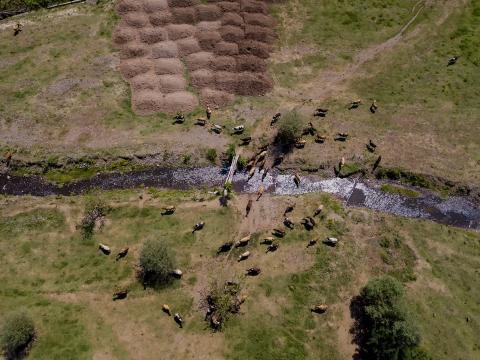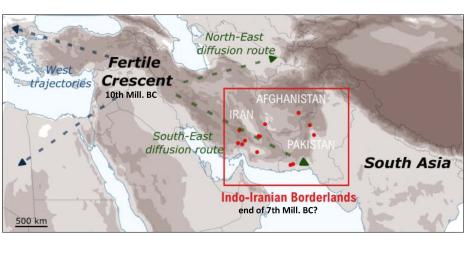
AGROCHRONO: understanding the development of agropastoralism in the Indo-Iranian Borderlands
The AGROCHRONO project, led by Emmanuelle Casanova, a research engineer at the Laboratory for Climate and Environmental Sciences (LSCE – Univ. Paris-Saclay/University of Versailles-St-Quentin in Yvelines, UVSQ/National Centre for Scientific Research, CNRS/French Alternative Energies and Atomic Energy Commission, CEA), and winner of an ERC Starting Grant 2024, aims to understand the development of agropastoralism in the border region between Iran and Pakistan during the Neolithic and Chalcolithic periods. The researcher and her colleagues plan to use a range of analytical methods and expertise, from archaeology to organic geochemistry, to ultimately generate diffusion models.
The Neolithic period was an important turning point in human history. It was during this period of prehistory that profound changes took place in their habits, techniques and lifestyles: from a nomadic hunter-gatherer, Homo Sapiens was gradually transformed into a food producer capable of acting on living matter, both plant and animal. This combination of plant cultivation – i.e. agriculture – and animal husbandry – i.e. pastoralism – is known as agropastoralism. This way of life, which coincides with the beginnings of humans' sedentary lifestyles and the establishment of villages, emerged 12,000 years ago in a region known as the Fertile Crescent, stretching from present-day Egypt to the Zagros mountains in eastern Iran. Agropastoralism then spread in many directions, to Europe, Africa and Asia, and became established throughout the world at various times.
However, the way in which this spread eastwards from the Fertile Crescent remains uncertain. And finding out is the aim of the AGROCHRONO project, led by Emmanuelle Casanova of the Laboratory for Climate and Environmental Sciences (LSCE – Univ. Paris-Saclay/UVSQ/CNRS/CEA): understanding the arrival and development of agropastoralism in the Indo-Iranian region. The project has been awarded an ERC Starting Grant 2024 by the European Research Council (ERC), which includes funding of 1.6 million euros over five years.
The border zone between Iran and Pakistan: a region where much can be learnt
While the spread of agropastoralism from the Fertile Crescent to the west, and in particular to Europe, has already been extensively studied, the eastern diffusion still raises questions. The area stretching from Fars, in the Iranian Zagros mountains, to the Indus Valley in Pakistan, is a new field of study. According to Emmanuelle Casanova, "in this region we can find a site with an archaic character where half of the animals appear to have been hunted, while the other sites show a majority of domesticated animals. At a time when ceramic technology had already been around since the 7th millennium BC in the Zagros mountains of Iran, it is not evident at a number of sites in south-eastern Iran and Pakistan. Last but not least, the Pakistani site of Mehrgarh provides the oldest evidence of domestication of the zebu, an animal native to the region."
These data raise the question of the chronology and routes of the diffusion of agropastoralism, which are not necessarily linear. The appearance of independent domestications of local animals and influences from other territories are to be expected. Furthermore, the environment ‒ extremely arid today, but undoubtedly more clement at the time ‒ must have been favourable to the establishment of agropastoralism. By focusing their study on this region during the Neolithic and Chalcolithic periods, which span the 7th to 4th centuries BC, Emmanuelle Casanova and her colleagues hope to shed some light on these conjectures.
A multi-disciplinary analytical approach
To achieve this, the team plans to analyse samples from various archaeological sites and lake sediment cores. "On the one hand, we'll be studying old excavations, carried out several years before the start of our project, and on the other, we'll be carrying out new excavations in Pakistan, resulting from exploration carried out at the beginning of the year," explains the LSCE researcher, who is collaborating on this project with Aurore Didier, Director of the French Archaeological Mission in the Indus Basin (MAFBI), and Benjamin Mutin, Neolithic archaeologist.
Analysis of these samples requires a panel of complementary expertise, the creation of PhD and post-doctoral jobs, and analytical support working in synergy. To study human eating habits, archaeobotanist Margareta Tengberg has to identify plant remains and determine the domestic and wild species present on the site. Archaeozoologist Marjan Mashkour will be carrying out the same work on animal remains, while Emmanuelle Casanova will examine the lipid residues of food in archaeological ceramics. In order to better understand the environmental setting in which these populations developed, palynologist Morteza Djamali will identify the pollens present in lake cores, while organic geochemist Jérémy Jacob will study organic molecules to obtain information on the vegetation, hydrology and temperatures of the period.
This multi-disciplinary analytical approach is AGROCHRONO's strength. "We've come to revisit excavations and old lake cores using new techniques, particularly chemical ones, which will provide us with much more information for understanding the sites and their environmental setting," the researcher enthuses.
Chemistry used to serve archaeology
With an educational background in chemistry, Emmanuelle Casanova plans to use an experimental strategy she developed during her PhD and post-doctoral fellowship: carbon-14 dating of specific molecules in order to reconstruct chronologies. This involves dating the organic residues, particularly lipids, present in ceramics from archaeological sites, an important approach in arid environments where the organic matter in bones, for example, is poorly preserved. First, the team must correctly select the samples to be dated: "We need to be sure that the carbon we're going to date in the sample has indeed stopped exchanging matter with the outside environment. We'll be basing our work here on the residual organic matter found on the ceramics."
The sample is then chemically treated to eliminate external contamination. This treatment ends with the isolation of specific molecules using preparative gas chromatography. Thanks to other upstream analyses, scientists are able to determine whether these are lipid compounds from milk, carcass or aquatic resources. Once extracted and isolated, the targeted compounds are burnt. The carbon obtained in this way is dated using the carbon-14 dating method, either directly in the form of a gas (CO2) or as graphite. "We use a laboratory instrument called ECHoMICADAS. It's a compact mass spectrometer and accelerator dedicated to measuring carbon-14.” The instrument provides the ratio between the different carbon isotopes present in the sample. "It directly measures the quantity of carbon-14 in relation to that of carbon-12 and -13." As the carbon-14 isotope is unstable, it decays over time into nitrogen. By knowing its relative abundance in a sample and the half-life of carbon-14 (the time it takes for half the carbon atoms to decay), scientists can date the sample.
However, as carbon-14 levels in the atmosphere are not constant, converting radiocarbon measurements into calendar ages is not that simple. "We use calibration curves for this, which are not necessarily linear. What we obtain is a probability of distribution of the event between such and such a date," Emmanuelle Casanova explains. The accuracy of the calibration is directly related to the accuracy of the measurement, but also to the variability of the calibration curve over the period of the samples to be dated. It is possible to limit the calibrated time intervals on the basis of relative archaeological information: "If we know that a given sample comes from an older layer than another, these stratigraphic constraints enable us to refine the ages, thanks to mathematical models used by software dedicated to calibrating carbon-14 measurements," the chemist explains.
With the ERC Starting Grant covering the project over five years, the team plans to generate the analytical data during the first three years, then devote the last two to modelling. It will then combine existing and generated data to better understand the environmental and temporal setting of the study, and finally propose scenarios for the arrival and diffusion of agropastoralism in the Indo-Iranian zone.

